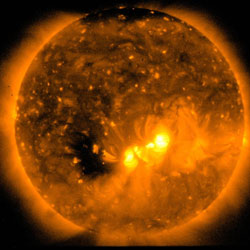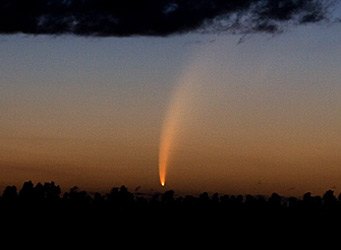Wait! Don't throw out your International Heliophysical Year calendars just yet. Even though 2007 is coming to an end, the IHY will last at least through early 2009, and that's when the International Year of Astronomy kicks in.

The Sun viewed in X-rays as seen by the Hinode satellite.
NAOJ, JAXA, NASA, and Harvard-Smithsonian Center for Astrophysics
We covered many stories about the interplay between Sun, space, and Earth over the past year, but perhaps none was more spectacular than the images and other results from Japan's Hinode spacecraft.
Japan's space program had a banner year — finally. While previous missions have had some serious problems, so far its newest space explorers are doing fine. The infrared telescope named Akari is seeing the universe's heat and the HDTV-camera toting Kaguya is orbiting the Moon. And shortly after the world marked the 50th anniversary of the birth of artificial satellites, China successfully lofted its first planetary orbiter, Chang'e 1, to join Kaguya in lunar orbit.
The year began with amateurs buzzing about the spectacular Comet McNaught; it ends with remarkable Comet Holmes still visible to Northern Hemisphere observers. But these two weren't the only tail-sporting surprises of 2007. Astronomers using an orbiting ultraviolet telescope discovered that well-known variable star Mira has one too!

Comet McNaught dazzled the Southern Hemisphere.
Andrew Drawneek
At the edge of the solar system, dwarf planet Eris was determined to be bigger than once full-fledged planet Pluto. And Voyager 1, which marked 30 years in space, is on the verge of leaving our Sun's influence.
Looking farther from Earth, astronomers discovered more extrasolar planets and amateurs helped. Reanalysis of satellite observations have provided us with more accurate distances to nearby stars. And astronomers have found a place in the far-flung universe where there doesn't seem to be much of anything.
While we hope that these and other findings announced at SkyandTelescope.com have piqued your interest in all manner cosmic discovery, year's end is also a time to reflect upon what we have lost during 2007: Thomas M. Back, Kenneth L. Franklin,
Fred Hess, Dorrit Hoffleit, Don Osterbrock, and Victor Winter.
What's in store for next year? You can prepare for known celestial events in our 2008 preview. But as we all know, it's the unexpected cosmic happenings that give us that extra thrill. We'll just have to wait and see what the universe brings.
Happy New Year!
 0
0
Comments
You must be logged in to post a comment.